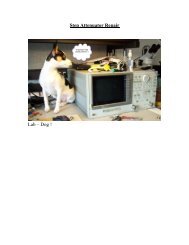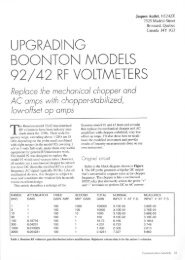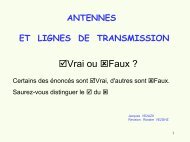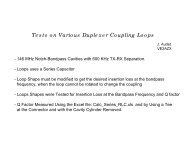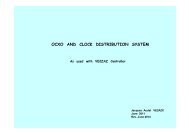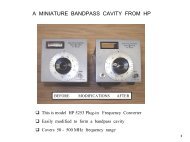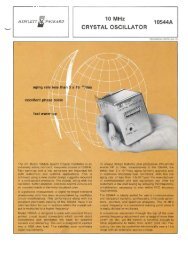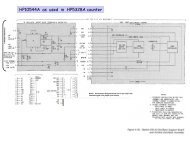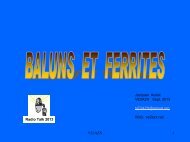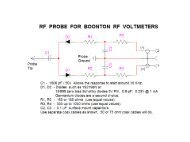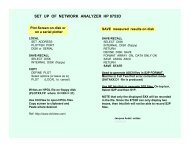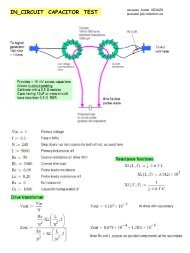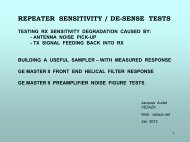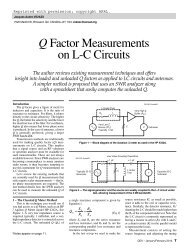Q Calculations of L-C Circuits and Transmission Lines ... - Ve2azx.net
Q Calculations of L-C Circuits and Transmission Lines ... - Ve2azx.net
Q Calculations of L-C Circuits and Transmission Lines ... - Ve2azx.net
Create successful ePaper yourself
Turn your PDF publications into a flip-book with our unique Google optimized e-Paper software.
approximation is valid for frequencies below<br />
25% <strong>of</strong> the quarter wave resonant frequency<br />
(~16.229 MHz), however. For both shorted <strong>and</strong><br />
open stubs, Equation 16 may be used to calculate<br />
the Q factor at all integer multiples <strong>of</strong> a<br />
quarter wavelength.<br />
Using a constant real value for the line<br />
impedance makes the Q factor versus frequency<br />
equal for both open <strong>and</strong> shorted lines.<br />
This method makes calculations much faster<br />
<strong>and</strong> simpler, but as shown in Figures 3 <strong>and</strong> 4,<br />
it will give very large errors in the Q <strong>and</strong> in<br />
the complex stub impedance. I also discovered<br />
that the common transmission line models<br />
used in my pr<strong>of</strong>essional RF-microwave<br />
circuit simulator use this shortcut too.<br />
Note the Q factor behavior below the quarter<br />
wave frequency F q . At frequencies below<br />
F q , the Q factor goes down for the shorted<br />
line while it goes up for the open line. This<br />
tells us that the line losses are mostly in the<br />
conductors (~1.8 dB/100 ft while the dielectric<br />
losses are ~ 0.14 dB/100 ft. at the quarter<br />
wave resonant frequency).<br />
It is also interesting to compute the Q factor<br />
versus line length at a fixed frequency.<br />
Figure 5 shows the Q factor at 16.229 MHz<br />
for a 10-foot length <strong>of</strong> RG-58C cable. Again<br />
the open line has a much higher Q factor below<br />
the quarter wave resonant length <strong>of</strong> 10 feet.<br />
Figure 6 shows the Q factor versus line<br />
length for a 1 foot length <strong>of</strong> RG-58C line.<br />
Decreasing the line length by a factor <strong>of</strong> 10<br />
has increased its resonant frequency by the<br />
same factor <strong>and</strong> the Q at self resonance goes<br />
from 36 to 100, a factor <strong>of</strong> ~3. This is possible<br />
since the losses are mainly conductor<br />
losses: 5.77 dB/100 ft <strong>and</strong> the dielectric losses<br />
are 1.36 dB/100 ft at 162.29 MHz. Note also<br />
that the loss tangent <strong>of</strong> the dielectric is 0.002.<br />
In contrast, PCB losses will be much<br />
higher with say, FR4 which has a typical loss<br />
tangent <strong>of</strong> 0.02<br />
The Q factor for a 50-Ω microstrip<br />
trace has been computed in Figure 7. The<br />
PCB loss tangent is 0.02 <strong>and</strong> the trace<br />
length is 3.469 inches to obtain quarter<br />
wave resonance at 500 MHz. At that frequency,<br />
the conductor losses are 5.7 dB/<br />
100 feet <strong>and</strong> the dielectric losses are<br />
47.5 dB/100 feet.<br />
Note that the open line now has its Q factor<br />
almost constant below quarter wave resonance.<br />
The Q factor <strong>of</strong> the shorted line is now<br />
much higher, in fact the shorter the line the<br />
higher the Q. The shorted stub becomes attractive<br />
as a resonator by using shorter lines<br />
with the higher Q. Then a low loss capacitor<br />
will be required to bring the line back to resonance<br />
at 500 MHz.<br />
Figure 8 shows the required stub loading<br />
capacitance versus line length to resonate at<br />
500 MHz. When the line length approaches<br />
a quarter wavelength, the required loading<br />
capacitance decreases toward zero.<br />
Real capacitors have a series resistance<br />
that limits their Q factor, however. In<br />
the next example, a series resistance <strong>of</strong><br />
0.08 Ω is assumed. The effective Q factor<br />
<strong>of</strong> the stub <strong>and</strong> the capacitor may be computed<br />
by recalling that the Q factors add<br />
like parallel resistors. There is now an<br />
optimum length that will provide the highest<br />
Q, which is around 1 inch or about<br />
25% <strong>of</strong> the original self resonant length.<br />
See Figure 9.<br />
The highest Q will generally be obtained<br />
by paralleling multiple capacitors<br />
to decrease the effective series resistance.<br />
Note that wider PCB traces will provide<br />
higher Q factors, even if the line Z o is<br />
lower.<br />
Substituting RG-174 coax gives a<br />
maximum Q <strong>of</strong> 100 at 2.5 inches, while a<br />
length <strong>of</strong> RG-213 shows a maximum Q <strong>of</strong><br />
394 at a quarter wavelength (3.9 inches).<br />
This means that a low to very-low-loss line<br />
will have its highest Q at a quarter wavelength<br />
<strong>and</strong> above. I have measured the<br />
unloaded Q <strong>of</strong> a 6-inch-diameter quarterwave<br />
resonator at 145 MHz in quarterwave<br />
mode <strong>and</strong> 430 MHz in ¾-wave mode.<br />
At 145 MHz, the unloaded Q was 5324<br />
<strong>and</strong> 9065 at 430 MHz: an increase by a<br />
factor <strong>of</strong> 1.7. This is also predicted by the<br />
models presented here.<br />
Note that adding a lossless reactance<br />
in parallel (or series) with the stub — to<br />
modify its resonant frequency — does not<br />
change its Q versus frequency as calculated<br />
from Equations 9 or 14. Only its resonant<br />
frequency is changed.<br />
So far from these simulations, Equations<br />
9 <strong>and</strong> 14 make sense for calculating<br />
the resonator unloaded Q for resonator<br />
lengths ranging from 1% <strong>of</strong> the wavelength<br />
to many wavelengths. At low frequencies<br />
where the resonator is less than 1 /16 wavelength,<br />
we get the same results by simply<br />
taking the reactance-to-resistance ratio to<br />
compute the Q factor instead <strong>of</strong> using the<br />
more complex Equations 9 <strong>and</strong> 14.<br />
Validating the Computed Resonator Q<br />
from the Calculated Stub Impedance<br />
A second method <strong>of</strong> calculating the<br />
resonator Q factor has been used to determine<br />
the limits <strong>of</strong> validity <strong>of</strong> Equations 9<br />
<strong>and</strong> 14 as applied to transmission lines.<br />
The resonator Q may be determined by<br />
finding the two frequencies f 1 <strong>and</strong> f 2 around<br />
the stub resonance that yield a stub impedance<br />
with a phase angle <strong>of</strong> ±45°. The<br />
exact stub resonant frequency is f r , where<br />
its input reactance is zero in the case <strong>of</strong><br />
series resonant lines. For lines that are<br />
parallel resonant, we use admittances <strong>and</strong><br />
note the frequency where the suceptance<br />
goes to zero. For Q factors above 10, f r<br />
can be taken as the average <strong>of</strong> f 1 <strong>and</strong> f 2 .<br />
The stub Q factor can then be calculated<br />
from:<br />
f r<br />
Q <br />
(Eq 34)<br />
f<br />
2<br />
f<br />
1<br />
Note that the stub impedance measurements<br />
may be done at either end <strong>of</strong> the line,<br />
without affecting the Q value.<br />
This method may also be used to compute<br />
the Q factor at frequencies other than at<br />
resonance by adding a lossless frequencydependant<br />
series reactance (L or C) in the<br />
case <strong>of</strong> a series resonant line. Similarly, parallel<br />
resonant lines require the addition <strong>of</strong> a<br />
susceptance in shunt with the line. This<br />
method was used to verify the accuracy <strong>of</strong><br />
Equations 9 <strong>and</strong> 14 with the help <strong>of</strong> Mathcad<br />
to do the calculations.<br />
Table 1 summarizes the results for a line<br />
length <strong>of</strong> 8.17 feet. The frequency for the<br />
losses is 5 MHz. The Q error was derived by<br />
using Equation 34 to compute the resonator<br />
Q from the impedance/admittance data <strong>and</strong><br />
comparing the values obtained with Equations<br />
9 or 14.<br />
At 28 MHz, we are about halfway between<br />
resonances, <strong>and</strong> either Equations 9 or<br />
14 may be used, for both shorted <strong>and</strong> opened<br />
lines. This value is the geometric average<br />
between the first <strong>and</strong> second resonances.<br />
As it can be seen from Table 1, the error<br />
is largest for Q values below 20 or so. The<br />
worst errors occur at the highest resonance<br />
modes having the lowest Qs. Below quarter<br />
wave resonance, the Q error is below 1% for<br />
Qs above 10.<br />
Computing Resonator Q from B<strong>and</strong>width<br />
Measurements at Multiples <strong>of</strong><br />
Quarter Wavelength Resonance<br />
Another way to verify the resonator Q<br />
factor is to build a b<strong>and</strong>-pass filter <strong>and</strong> measure<br />
its selectivity by measuring its –3 dB<br />
points on an S21 display. To precisely determine<br />
the resonator Q u (unloaded Q), the coupling<br />
<strong>of</strong> the stub under test to the source <strong>and</strong><br />
detector will have to be very small. Equation<br />
34 is used to compute the resonator Q factor.<br />
Figure 10 shows the circuit that I have used<br />
for my simulations on a line, which behaves<br />
as a parallel LC resonator.<br />
In Figure 10, the source <strong>and</strong> detectors have<br />
low impedance (50 Ω). The stub is coupled<br />
to the source-detector via 0.1 pF capacitors.<br />
This method is useful to determine the resonant<br />
frequency <strong>of</strong> a shorted quarter wave line,<br />
since it presents the highest impedance at<br />
resonance. Again, Equation 34 is used to<br />
compute the stub unloaded Q factor, where<br />
f 1 <strong>and</strong> f 2 are the –3 dB frequencies, as measured<br />
from the resonant frequency f r . Note<br />
that the source <strong>and</strong> load resistive impedances<br />
will decrease the Q factor somewhat. Equation<br />
35 may be used to calculate the unloaded<br />
48 Sep/Oct 2006



